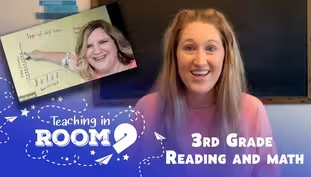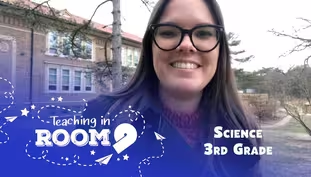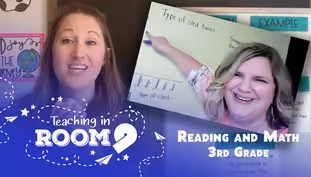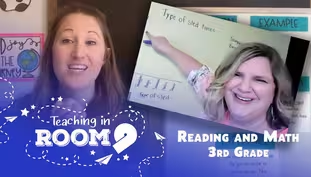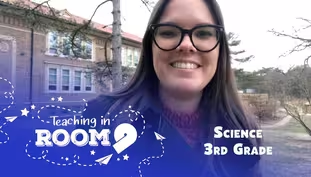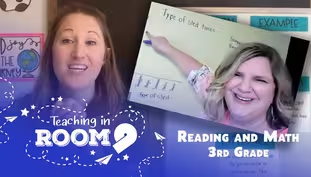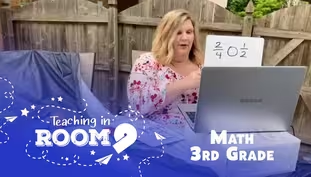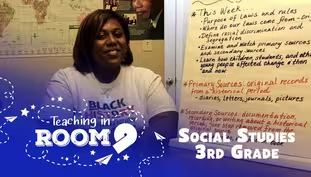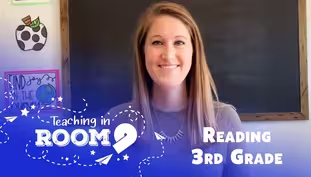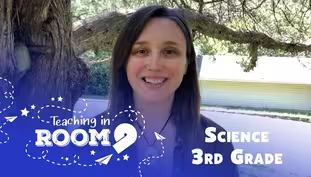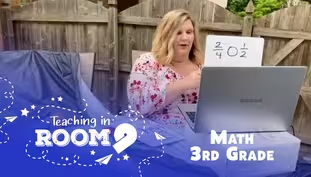Teaching in Room 9
Self-Monitoring | I Love Word Problems | 3rd Reading/Math
Special | 26m 56sVideo has Closed Captions
Students learn to self-monitor by asking themselves the question "Does it sound right?"
Students learn how to self-monitor by asking themselves the question "Does it sound right?" as they read practice sentences. Then they solve a word problem involving equal groups. Mrs. Brewer shows different strategies that can be used to break down and solve a problem. / Julia St. Louis, Mehlville School District, Rogers Elementary School / Carrie Brewer, East Saint Louis School District 189
Problems playing video? | Closed Captioning Feedback
Problems playing video? | Closed Captioning Feedback
Teaching in Room 9 is a local public television program presented by Nine PBS
Teaching in Room 9
Self-Monitoring | I Love Word Problems | 3rd Reading/Math
Special | 26m 56sVideo has Closed Captions
Students learn how to self-monitor by asking themselves the question "Does it sound right?" as they read practice sentences. Then they solve a word problem involving equal groups. Mrs. Brewer shows different strategies that can be used to break down and solve a problem. / Julia St. Louis, Mehlville School District, Rogers Elementary School / Carrie Brewer, East Saint Louis School District 189
Problems playing video? | Closed Captioning Feedback
How to Watch Teaching in Room 9
Teaching in Room 9 is available to stream on pbs.org and the free PBS App, available on iPhone, Apple TV, Android TV, Android smartphones, Amazon Fire TV, Amazon Fire Tablet, Roku, Samsung Smart TV, and Vizio.
More from This Collection
A collection of 3rd Grade Lessons from Teaching In Room 9.
Using Context Clues/Space Week Blast Off | 3rd Reading/Math
Video has Closed Captions
Campers will learn about context clues to determine the meaning of nonsense words. (28m 55s)
Adapting to Change: Ecosystems Change Overtime | 3rd Science
Video has Closed Captions
Students learn what Missouri looked like millions of years ago. (27m 42s)
Literal & Non-literal Phrases | Line Plots |3rd Reading/Math
Video has Closed Captions
Students determine the meaning of non-literal phrases & review creating a line plot. (27m 44s)
Using Context Clues | Bar Graphs | 3rd Reading/Math
Video has Closed Captions
Students practice using context clues and how to create a bar graph. (27m 28s)
Observing Weather| 3rd Grade Science
Video has Closed Captions
Students learn to describe the climate they live in and climates around the world. (28m 28s)
Decoding Prefixes/Snow-Ticings & Wonderings|3rd Reading/Math
Video has Closed Captions
Students will learn about common prefixes & decode the meaning of words that have them. (27m 45s)
Video has Closed Captions
In this lesson, Mrs. Brewer introduces the concept of volume to the students. (28m 57s)
Missouri Capital History | 3rd Grade Social Studies
Video has Closed Captions
Students review how Missouri became the 24th state. (26m 45s)
Making Connections to A Text | 3rd Grade Reading
Video has Closed Captions
Students will practice making connections to a text to build their comprehension. (27m 42s)
How Things Move - Magnetism | 3rd Grade Science
Video has Closed Captions
In this lesson, students explore magnetism through several hands-on investigations. (28m)
Liquid Measurements | 3rd Grade Math
Video has Closed Captions
Students are introduced to ways to measure liquids using a GallonBot. (27m 21s)
Asking Questions About A Text | 3rd Grade Reading
Video has Closed Captions
Students will practice asking & answering questions about a text to build comprehension. (29m 22s)
Providing Support for PBS.org
Learn Moreabout PBS online sponsorship(melodious instrumental music) - Hi everyone.
And welcome back to Room 9.
Our region's largest classroom.
My name is Mrs. St. Louis and I'm a teacher at Rogers Elementary School in the Mehlville School District.
And we are located in south St. Louis County.
Today, I'm here to teach a reading lesson that's geared towards students who are in the third grade but all learners are more than welcome to join and explore along with us.
So let's get started.
Now this week we are talking all about how to become more fluent readers by self-monitoring our reading.
So as a reminder, self-monitoring is when readers recognize when their reading is not right and they take action to fix it.
So as good readers who self-monitor, we ask ourselves some questions, and those are.
Does it look right?
Does it sound right?
And does it make sense?
So yesterday we dived into that question, does it look right?
And we talked a lot about how the letters have to look right.
And sometimes if we mix up the letters, if we add letters or take letters away, it can cause words not to look quite right.
Today we're gonna dive into another part of self-monitoring.
And we're gonna be talking about, does it sound right?
So thinking about how words sound.
So, we know that in our English language there's a lot of rules.
We have words that are in past tense that tell us things that happened a long time ago.
We have words that tell us about present tense, things that happen now.
And we have words that are in the future tones that tell us about things that are going to happen.
And so all of those words come with different endings and can definitely change things up.
And if we use the wrong one, that definitely can make it so words don't sound right.
Sometimes when we're reading, we also might skip words.
We might change words, or sometimes we even add words or word parts to words that cause it not to sound right.
So, today we're gonna talk about what we can do when things just don't sound right.
And so what we do is we take some of our action steps, and those action steps are, stopping and thinking.
Hmm.
Asking ourselves, well, huh, that didn't sound right.
Why didn't that sound right?
Taking the opportunity to go back and reread.
If there's ever a problem, we should always try and fix it.
Okay.
Think about your bike.
If there was ever something wrong with your bike and maybe the pedals didn't spin anymore, are you just gonna keep trying to ride your bike?
No, you're gonna stop and you're gonna try and fix it.
And sometimes that means going back and looking at all the pieces, just like when we reread, right.
And it's gonna help us to build our word solving strategies.
Every single day when we come across new words, we are adding new skills and strategies to our word solving bucket.
So that way when we come across some tricky words again, it's little bit easier for us to solve them.
So, thinking about, does it sound right?
We're gonna be looking at some sentences today that don't quite sound right.
We're gonna be taking the opportunity to fix them up.
So what I'm going to do is I'm going to read the sentences to you first without letting you see the sentence.
And I want you to just think in your head.
Hmm.
What word doesn't sound right as I read it.
Then we'll take a look at the actual sentence, see if we can figure out what the problem is and fix it up.
Are you ready?
All right, here's our first sentence.
I can't find my shoes.
Have you saw them?
Let's read it again.
I can't find my shoes.
Have you saw them?
Some doesn't quite sound right there.
Do you know what it is?
Let's take a look at the sentence as we read it and see if we can figure out where our problem is.
I can't find my shoes.
Have you saw them?
What do you think might be the issue here?
That's right, saw, right.
Have you saw them?
Hmm.
It doesn't quite go there, right?
I'm talking right now, this sentence is written in the present tense, right?
I can't find my shoes.
I'm looking for them right now.
Saw refers to the past tense, right?
Ah, I saw them yesterday.
But I'm not looking to see if you saw them yesterday, I'm looking to see if you seen them today.
So what word would fit here?
Right, seen, right.
I'm talking about right now.
Have you seen them around?
Have you seen them here, right?
Thinking about it in that sense.
Now it sounds right.
Have you seen them?
All right, let's do another one.
Are you ready?
I can't waited for the weekend.
I can't waited for the weekend.
Oh, I can tell you are already starting to figure it out, but let's look at it as we read the sentence and really see if we can figure out what doesn't quite sound right here.
I can't waited for the weekend.
That's right, it's waited.
When we have the ed on the end, that refers to something that's happened in the past, right?
So I waited, would be something I did yesterday.
But the weekend's not here yet, so it's something that's happening in the future.
So what would make sense in this sentence?
What would sound right here?
That's right.
I can't wait for the weekend.
So we can see that by adding that extra ending on there, the ed, things didn't sound right.
It made our sentence a little bit confusing.
So by stopping, taking a moment to reread, thinking about, hmm, what's not quite right, and taking the opportunity to fix it.
Now everything makes sense.
And I can continue on with my reading.
Let's try another sentence.
Oh.
The sloth is moves slow.
The sloth is moves slow.
Now that doesn't sound right.
Hmm.
Let's see if we can figure this one out.
The sloth is moves slow.
What's going on here?
What doesn't sound right?
Yeah.
Is moves?
We don't say that.
That doesn't sound right.
Does it sound like proper English grammar?
Definitely something's off here.
But here's my tricky question the day.
How do I fix this sentence to make it sound right?
Okay.
I see that some of you were saying I should just take is.
The sloth moves slow.
How does that sound?
Definitely sounds better, right?
Definitely is like, oh, okay.
That sounds right.
That sloth moves slow.
But what if I told you we can't take out the word is.
Then what?
Is there a way to make this sound right by keeping the word, is, in there?
I see those gears turning.
Yes.
I can change the ending on the end of the word move.
So instead adding s, if I put in, ing, on the end, the sentence could read, the sloth is moving slow.
How does that sound?
Definitely sounds better, doesn't it?
So you can see that sometimes there might be more than one way to correct a sentence.
And as we know these sentences aren't really sentences that are actually in a book.
They're ones that I made up.
So that's where looking at your sentence in the book, taking the time to slow down and reread is going to help you, because sometimes more than one thing could be changed.
Right?
So just as we've seen here, it could be that I added in a word as I was reading or it could be that I changed an ending as I was reading.
So by going back and rereading the sentence I'm gonna be able to figure out what the mistake was and fix it.
Let's try another one.
Oh, I wasn't supposed to show you yet.
Did you see it?
I hope not.
All right, let's try it.
I am go to play soccer with my friends.
I am go to play soccer with my friends.
Something doesn't quite sound right there.
Hmm.
You ready to look at it?
I am go to play soccer with my friends.
Hmm.
Yeah, it's that beginning, right?
I am go.
What?
That doesn't sound right.
So what can I do to fix it up to make it sound better?
That's right, that ing.
I am going to play soccer with my friends.
Now, it sounds better.
All right, let's see.
I think we can do another one.
Are you ready?
Hmm.
Are you ready?
Let me try and check it out.
See if we can figure it out.
Please go picked up the cake.
Please go picked up the cake.
What do you think?
Let's look at it.
Please go picked up the cake.
That's right, go picked.
I'm asking you to do something, right?
Do it now.
Do it in the future.
But picked with an ed, that tells me about something that happened in the past.
But I'm asking you, you haven't done it yet.
So, that definitely doesn't sound right.
So, what can we do to fix it up to make it sound better?
That's right, take the ending off.
Please go pick up the cake.
Now it sounds a lot better.
Don't you think?
I agree.
So boys and girls, today, we continue to talk about self-monitoring and how as readers read they're paying attention to the words around them to try and figure out, is this right?
And if it's not, taking some action steps to solve the problems.
So today we talked about what to do when things don't sound right.
When as you're reading you go, whoa, that's not right.
And taking opportunity to look closely at sentences to figure out why doesn't it sound right, and what can I do to fix it up.
So, so far this week we've tackled two of the key pieces of self-monitoring.
Does it look right?
Does it sound right?
And if you join us back tomorrow we're gonna tackle piece number three.
Does it make sense?
But until that's time, I think we switch on over to a little bit of math.
What do you think?
Off we go.
- Thank you so much Mrs. St. Louis, Once again, fabulous reading lesson.
I learned a lot.
How about you, boys and girls?
Awesome.
I am so happy to see you, boys and girls here today because I know this week something big was happening.
I know that we had something awesome happening this week.
And, oh, you ever have that happen, boys and girls where you know there's something going on, you got to remember it and you just can't.
That is where I am right now, boys and girls.
I've been looking all around here, I've been asking everybody.
Nobody can help me.
Wait.
I just looked on my calendar, boys and girls.
Once again, you guys have helped me.
Guys, what month we are in?
We are in February, 2021, right?
Now look, what day in February is important?
Do you see?
What do I have circled?
What is that date?
It's February 14th.
What is February 14th, boys and girls?
(gasps) It is Valentines Day.
And there is one thing I love more than most.
That is Valentine's Day, boys and girls.
I kept thinking my wall back here looks so plain.
Yeah, it looks plain because guess what it's missing.
Valentine's Day decorations.
I always have this ready.
What about you boys and girls?
Are you excited about Valentine's Day?
I'm sure you are.
And I'm sure those of you back in school are probably ready to have some Valentine's Day parties, aren't you?
Hope it's safe of course, right?
And so for those of you that are still at home like me, well, let's have our own Valentine's Day party this week.
What do you think, boys and girls?
Absolutely.
I think we need to get ready.
Like I said, first things first, we need to decorate, right?
All right.
So I might not be done just yet but it's a start, isn't it?.
My walls will get just a little more festive and a little more better, isn't it?
I got some garland I can hang up later on to kick off our Valentine's Day week.
Boys and girls, do you know why I love Valentine's Day so much?
Because this is the day I get to tell everybody why I love them.
Absolutely.
I'm sure everybody has someone in their life that they love.
Who do you love, boys and girls?
And I'm not talking just boyfriend, girlfriend.
Yeah, yeah, yeah.
I got a husband, I love him too, okay.
But I'm talking about my kids.
I'm talking about my students.
I'm talking about you boys and girls that are here with me.
There are so many things that I can go on and on and on about that I love.
And especially multiplication.
Oh yeah.
What's a holiday party week without multiplication, right?
You know I love math, but most of all, I love my multiplication.
So this week, boys and girls, we are gonna be working on Valentine's Day word problems.
What could be better, right?
I know you all were thinking that, that you love math and you could not wait to get working on some Valentine's Day work problems.
Boys and girls, so get ready for the holiday.
I have, are you ready?
Of course what's the first thing you have to have for an awesome Valentine's Day party?
Yeah.
We have to kick it off with some Valentines, right?
This year.
I think I'm gonna give some Trolls and some Super Mario Brothers.
Boys and girls, what kind of Valentines are you hoping to give out this year?
Well, I am sure whoever gets it will most definitely love it.
Get it?
They'll love it.
Right, right.
Cause it's Valentine's Day.
We love everything, right.
Let me see, what else do I have sitting around here for Valentine's Day?
Oh.
One of the other best things.
Some chocolates.
Actually I have some peanut butter hearts here, okay.
Some of you are thinking, I'm allergic to peanut butter.
Don't eat the peanut butter hearts.
All right.
But, see these, boys and girls.
Oh yeah.
It looks like there's gonna be some great math problems inside here for us, boys and girls.
What else do I have?
Oh, I can't forget.
I also have the sugar-free chocolates here for those of my students that might need the sugar-free chocolate as well.
Hmm.
What else do I need for Valentine's Day?
Oh yeah.
Stickers.
We can't have Valentine's Day without some hard stickers, can we?
Absolutely not.
We cannot.
All right.
Ooh.
Another thing I have is my, you might've thought this was a scarf.
It's not a scarf.
This is more garland for Valentine's Day to help decorate.
We can never be too fancy when it comes to Valentine's Day, can't we, boys and girls?
Absolutely not.
What's that you said?
I just heard someone say, I didn't get any Valentine's yet.
Hm.
Well, and if you don't get any, what can we do?
So think about the people in your house with you, boys and girls, they still need to know that you love them, right?
So Valentine's Day doesn't always have to be ones that we buy from the store.
A little Super Mario Brothers, all right.
But sometimes, boys and girls, the gifts from the heart that means the most are homemade gifts that come from you.
So if you don't have any Valentine's there with you at home, boys and girls, guess what?
You're in luck, because you have the queen of hearts right here, boys and girls.
That's right.
That's right.
Mrs.
Brewer loves Valentine's Day so much that I will show you today how to make a homemade Valentine for someone in your house that you might wanna give.
Maybe your mom, your dad, your aunt, your uncle, your granny, your grandpa, whoever it may be.
All you need boys and girls is this right here, a piece of paper.
Just a piece of paper.
Who has paper?
I have paper.
Does it have to be construction paper?
Not at all, boys and girls.
So what I want you to do, I'm gonna give you 10 seconds to grab a piece of paper and you're not just gonna need paper, you're also gonna need scissors.
Do you have scissors, boys and girls?
All right.
So if you do, go ahead and grab them.
If not, I think I might have plan B for you, boys and girls.
If you have a piece of paper, it might take a little bit longer but go ahead and grab these things if you have them, your scissors doesn't have to be as big as Mrs.
Brewers.
I'm a grownup, so I need bigger scissors, all right.
So go ahead and grab paper, scissors.
Oh, one more thing.
If you haven't have a pen, marker, or something to write with, go ahead and grab that too.
In 10, nine, eight, seven, six, five, four, three, two and one.
Welcome back.
Welcome back.
All right.
So now I want you to take your paper that you have and we are going to hold it hot dog styles.
Okay.
Hot dog styles like this means it's the long ways, all right.
And we are holding it hot dog style but we are gonna fold it hamburger style.
So that means holding it this way.
I'm gonna take this end and I'm gonna fold it in to meet the other side right here.
See what I did?
See what I did?
Okay.
We just folded it in half hamburger style, boys and girls.
And when you have it folded in half, go ahead and give that edge a crease and fold right down, and get it as good as you can get, okay.
So see my end right here.
So you open it up, it looks like a book.
Don't worry.
You can actually do this, write it like a card if you want it, okay.
Since it's Valentine Day I'm going for a little bit something.
A little more from the heart.
Get it?
The heart.
Okay.
All right.
So now what I want you to do, you are going to take that something you have to write on and you are going to start holding that paper like this.
Okay.
You see this here?
This is my folded in right here.
So if I opened it up, I open up from right here, okay.
So I'm gonna start right here from this folded in.
And I am going to draw half of heart.
And when I put the corner of my heart I'm gonna make sure it goes right there at the corner of my paper.
See how that looks like half the heart right there?
And if you even want it to start, I don't know why I always start at the top.
I always have, since I was probably younger than you boys and girls.
If you want to start at the corner and come up and draw your heart, that's fine.
All we're doing is drawing half a heart.
Let me know when you got that done.
All right.
Looking like most of you guys are done right now.
So we're done with the marker right now, you could put that to the side, okay.
Next step.
You are gonna grab your handy-dandy scissors and we're gonna cut out right on that line what you drew.
Okay.
My paper is still folded in half, okay.
And I'm gonna start cutting right here from this corner, right?
You're gonna see Mrs.
Brewer go cut, cut, cut, cut, cut.
Cutting on that line, as close to that line.
If you get out of that line, it's okay.
I'm already out of that that line.
It's okay.
Telling that more to myself than you boys and girls.
All right.
So cut.
I'm done.
I'm left with this, my half of heart.
So guess what I'm gonna do now, boys and girls.
You ready?
I am gonna open it up.
And what did I just make?
I just made a, a whole heart, right?
So now on here, boys and girls, I can leave it folded like this.
See, I didn't cut right on my line.
I can leave it folded like this and say, to Ellie.
This one's gonna be for my daughter, Eleanor, okay.
So we can write on the inside, so when they open it up, they get the whole heart for their card.
Or right here on the inside you can write, to Ellie, you are so amazing.
Thanks for being the best daughter ever, love mom.
Okay.
So you can write what you want on the inside, boys and girls.
So your Valentine does not have to be something that we bought from the store.
They can be homemade like I just showed you, boys and girls.
So here I would start, to Eleanor, and I could write her whole message on here, and at the end I will put, love mom.
She calls me mom.
I'm her mom.
Okay.
All right.
So boys and girls, I hope you stick with us all week because you are going to love what we do this week.
I will see you right back here tomorrow for some more Valentine's Day fun.
(melodious instrumental music) - [Narrator] Teaching in Room 9 is made possible with support of Bank of America, Dana Brown Charitable Trust, Emerson, and viewers like you.
(melodious instrumental music)
Support for PBS provided by:
Teaching in Room 9 is a local public television program presented by Nine PBS
